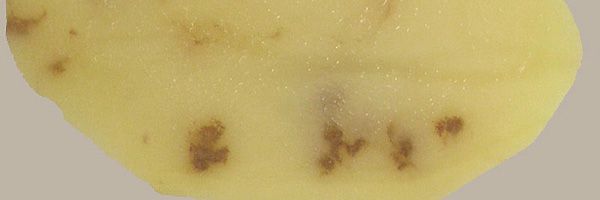
Internal rust spot, internal brown spot
- Symptoms
The phenomenon of rust spots (also called physiological rust) is characterised by the presence in the flesh of the tubers of round necrotic areas. These are rust-brown and of irregular shape and size (photos 1 to 3).
Whilst these lesions may be localised in all the internal area of the vascular ring, they usually appear more intensively next to the rose-end, in the perimedullar parenchyma. They do not develop further during storage.
Although these symptoms are quite common in potatoes grown in sandy soils, they can be observed in all types of soil, their intensity varying according to the year. They may be confused with lesions localised around the vascular ring or the heel-end.
These can be a result of a flesh reaction to various factors: chemical haulm desiccant, thermal stress at the end of the vegetative cycle, Verticillium wilt, late blight or infection by various viruses such as Tobacco rattle virus (TRV) and Potato mop-top virus (PMTV) and Y Necrotic potato virus (PVYNTN)
Symptoms of TRV or of PMTV can develop both inside and outside the vascular ring. In a few rare cultivars (Russet Burbank for example), Potato leaf roll virus (PLRV) may also cause brown necroses, localised chiefly at the vascular ring: net necrosis.
- Risk factors
Physiological rust is often due to a disorder of the metabolism, an enzymatic disorder in particular, caused by intense heat or excessive drought during tuber formation.
However major symptoms have also been observed in cold, humid years in some plots. Insufficient calcium assimilation by the plant or a calcium deficiency in the tuber may also cause these symptoms.
Furthermore, in some cultivars, these symptoms can be caused by a too rapid tuber enlargement following inhibited growth (e.g. during drought).
This phenomenon is also associated with varietal susceptibility.
- Control measures
It is advisable to avoid susceptible cultivars in regions of high-risk soil.
The extent of these symptoms can be limited by large ridges and frequent, but not excessive, irrigation to prevent the tubers from enlarging too quickly.
On planting, the application of calcium in a readily-absorbed form, (e.g. calcium nitrate, calcium sulphate = gypsum), may also prove effective and a number of studies have pointed to a reduction of the symptoms by the use of maleic hydrazide.





